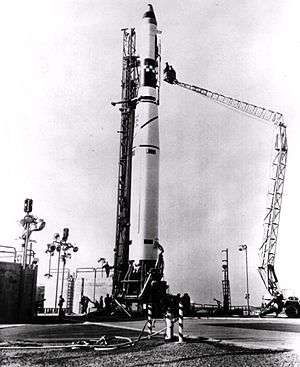SOLRAD 6
SOLRAD (SOLar RADiation) 6 (also called SOLRAD 6A) was the sixth solar X-ray monitoring satellite in the United States Navy's SOLRAD series, the third in the series to successfully orbit. It was launched along with POPPY 2, an ELINT surveillance package, as well as three other satellites, boosted into orbit via a Thor Augmented Delta-Agena D rocket on June 15, 1963.
| Mission type | Solar X-ray |
|---|---|
| Operator | NRL |
| COSPAR ID | 1963-021C |
| SATCAT no. | 00599 |
| Start of mission | |
| Launch date | June 15, 1963 |
| Rocket | Thor Augmented Delta-Agena D |
| Launch site | Vandenberg Air Force Base Space Launch Complex 1, Pad 1 |
| End of mission | |
| Decay date | July 31, 1963 |
| Orbital parameters | |
| Reference system | Geocentric |
| Regime | Low Earth |
Background
The SOLRAD science satellite program was conceived in 1958 to observe the Sun in the X-ray spectrum. It was quickly combined, to provide civilian cover (launches being unclassified at that time)[1], with the concurrently conceived United States Naval Research Laboratory's GRAB satellite project,[2] which would collect information on foreign radars and communications installations.[3] There were five SOLRAD/GRAB missions between 1960–62, with the scientific SOLRAD experiments sharing satellite space with GRAB's intelligence payload. Two of the missions were successful.[2]
In 1962, all U.S. overhead reconnaissance projects were consolidated under the National Reconnaissance Office (NRO), which elected to continue and expand the GRAB mission starting July 1962[4] with a next-generation set of satellites, code-named POPPY.[5] With the initiation of POPPY, SOLRAD experiments would no longer be carried on electronic spy satellites; rather, they would now get their own satellites, launched alongside POPPY missions to provide some measure of mission cover.[6]
The first POPPY mission was launched on December 13, 1962 along with several other satellites on a mission similar to that of SOLRAD 3, complete with an Injun (satellite) ionospheric research satellite.[6] The mission was successful, despite POPPY 1's elliptical (rather than the planned circular) orbit, and data was returned for 28 months.[7] No SOLRAD was launched concurrent with this first POPPY mission.[2]

Spacecraft
SOLRAD 6 (also called SOLRAD 6A)[2] was larger than its SOLRAD/GRAB predecessors: 24 inches in diameter (from 20) and with a nine-inch equatorial band giving the craft an elongated rather than spherical form.[5] The satellite was equipped with six X-ray detecting ion chambers, two more than its predecessors,[2] covering the ranges of 0.1-1.6Å, .5-3Å, 2-6Å, 2-8Å, 8-16Å, and 44-60Å.[8]
Mission and results
Launched on June 15, 1963 (COSPAR 1963-021C) via a Thor Augmented Delta-Agena D rocket from Vandenberg AFB with four other satellites,[6] SOLRAD 6 was placed into an incorrect elliptical orbit, its perigee so low that the atmosphere soon caused the satellite to decay from orbit[7] on July 31, 1963.[9]
Because of its short orbital lifetime, SOLRAD 6 returned relatively little data. Moreover, the Sun was very quiet during the satellite's six weeks of operation, and the four Lyman-Alpha photometers capable of registering X-ray emissions with wavelengths shorter than 8Å reported no results. No scientific data were ever published from SOLRAD 6's measurements, and the strip chart recordings of them were no longer available as of 1991.[8]
References
- Day, Dwayne A.; Logsdon, John M.; Latell, Brian (1998). Eye in the Sky: The Story of the Corona Spy Satellites. Washington and London: Smithsonian Institution Press. p. 176. ISBN 1-56098-830-4.
- American Astronautical Society (August 23, 2010). Space Exploration and Humanity: A Historical Encyclopedia [2 volumes]: A Historical Encyclopedia. Santa Barbara, Calif: ABC-CLIO. pp. 300–303. ISBN 978-1-85109-519-3.
- Parry, Daniel (October 2, 2011). "NRL Center for Space Technology Reaches Century Mark in Orbiting Spacecraft Launches". U.S. Naval Research Laboratory. Archived from the original on January 7, 2019. Retrieved January 12, 2019.
- "Review and Redaction Guide" (PDF). National Reconnaissance Office. 2008. Archived (PDF) from the original on April 23, 2016. Retrieved January 24, 2019.
- "History of the Poppy Satellite System" (PDF). National Reconnaissance Office. August 14, 2006. Retrieved February 28, 2010.
- McDowell, Jonathan. "Launch Log". Retrieved December 30, 2018.
- Day, Dwayne A. "A flower in the polar sky: the POPPY signals intelligence satellite and ocean surveillance". The Space Review. Retrieved February 17, 2019.
- Kahler, S. W.; Kreplin, R. W. (1991). "The NRL SOLRAD X-ray Detectors: a Summary of the Observations and a Comparison with the SMS/GOES Detectors". Solar Physics. 133 (2): 371. Bibcode:1991SoPh..133..371K. doi:10.1007/BF00149895.
- "SOLRAD 6". NASA Space Science Data Coordinated Archive. Retrieved January 10, 2019.